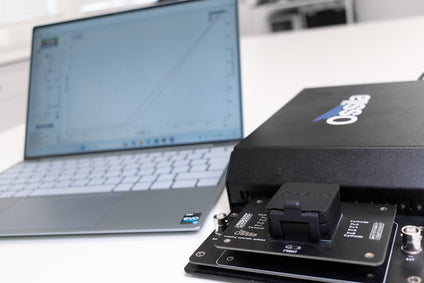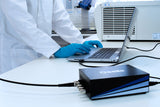Example Uses for a Source Measure Unit

A source measure unit (also known as a source meter or SMU) is a versatile tool widely used in electronic testing and characterization. Learn about real-world example applications and understand how an SMU can accelerate your measurements and enhance your data accuracy.
What Can You Use a Source Measure Unit For?
Solar Cell Characterization
The primary method of characterizing solar cells is to take an I-V curve measurement (also known as a J-V curve). From this curve, you can work out several key metrics, including JSC, VOC, and FF. These metrics allow you to determine the power conversion efficiency, which is the standard metric for solar cell efficiency.
You can also use the I-V curve to investigate material properties and diagnose problems with your solar cell. Source measure units can additionally track current or power to assess your solar cells stability.
Taking an I-V Curve Measurement
For this measurement, you will need just one of the SMU channels. Using a source measure unit combined with an electric testing board, you can easily write a programme to measure your I-V curve and extract key metrics. You need to measure and plot the current that flows through your device at different voltages.
Steps to consider when desinging this code include:
- Solar illumination source. You will need to use a calibrated solar simulator to illuminate your solar cell before measurement. Ensure your solar simulator is properly positioned before you start your measurement.
- Defining your voltage range. Your chosen voltage range and voltage step may vary depending on the device you are testing. We recommend sweeping between 0-1.2 V with a step of 0.01 V.
- Hysteresis. If you are measuring perovskite solar cells (or any device which shows hysteresis), you must do both a forwards sweep (0→1.2 V) and a reverse sweep (1.2→0 V).
- Device area. You should divide current by the device active area to measure current density. You can define the active area clearly using an aperture mask.
- Device metrics. In your code, you can extract VOC, JSC, FF, and PCE directly from the graph. Save this into a separate folder or csv file; this will save you some work later on.
Alternatively, you could begin your solar cell testing immediately with the Solar Cell Testing Kit which includes free Solar Cell I-V software.
LED Testing
I-V curves can also be used to characterize LED devices (such as OLEDs). From the I-V curve you can work out characteristics like the voltage threshold. I-V curves are useful for estimating the current produced at various voltages.
As with solar cells, you can diagnose device issues from an I-V curve and source measure units can also be used to test LED stability or track OLED aging.
Taking an IVL measurement

For LED characterization, I-V curves are combined with measurements of luminance to measure current-voltage-luminance (IVL) curve. IVL measurements can be used to determine both the currect efficiency and power efficiency of your LED. For this you will need to:
- Take a standard I-V sweep over a defined voltage range using a source measure unit, or equivalent. Most LED "turn on" voltages are between 1.8-3.5 V, so the voltage range needed will depend on the LED.
- Simulataneously, you will need to measure luminance using a luminescence meter or other photodiode system.
- You can then use both data sets to find the turn-on voltage, the current efficiency, and power efficiency of your LED using the equations below.
We have integrated our source measure unit with built-in light systems to make our LED measurement system. With free LED IVL software included, it is easy to measure luminosity and current simultaneously. The Ossila LED Measurement System is built to enable a rapid but simple characterization workflow so you can plug in the system, install the PC software, and start testing straight away.
Field Effect Transistor Testing
Source measure units can be used to measure field-effect transistors (such as OFETs, MOSFETs), which are also characterized through I-V measurements. By measuring the current that flows between the source and drain terminals at different gate-source voltages (VGS), you can assess the efficiency of your FET.
- Apply a set voltage to the gate using one channel on the SMU (for example SMU 2 on the Ossila Source Measure Unit).
- On a separate channel (e.g. SMU 1 on our source measure unit), measure an I-V curve between the source and drain terminals of the OFET device.
- Once this is complete, the measurement is repeated for various VGS.
For futher assistance, we have written a code to measure FETs using a source measure unit.

Other Applications
Battery Testing
You can use voltmeter channels (VS1 and VS2) of the source measure unit to measure some battery properties.
Using the VSense channels, you can measure voltage charge and discharge curves. This is a simple way to determine battery lifetime and can be helpful way to measure and plot some fundamental properties of small scale batteries.
However, the SMU should not be used to measure external voltages
Resistance and Conductance
SMUs can measure the resistance of a component or the conductance (reciprocal of resistance) quickly and accurately. This is particularly valuable in electronics testing, semiconductor characterization, and materials research for assessing device performance and ensuring product quality.
Source Measure Unit

Read More
 Example Uses For A Source Measure Unit
Example Uses For A Source Measure Unit
Source measure units (also known as source meters or SMUs) are versatile tools widely used in electronic testing and characterization. This article explores the practical applications of SMUs.
Read more... Source Measure Unit Software Guide
Source Measure Unit Software Guide
To engage the software, first connect the Source Measure Unit. The system has two SMU channels and two Voltage channels. Each channel can be activated using the power buttons on-screen
Read more...